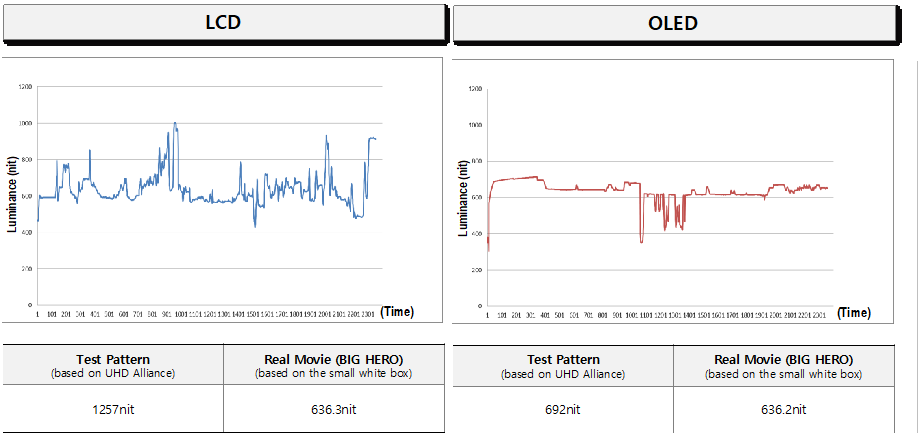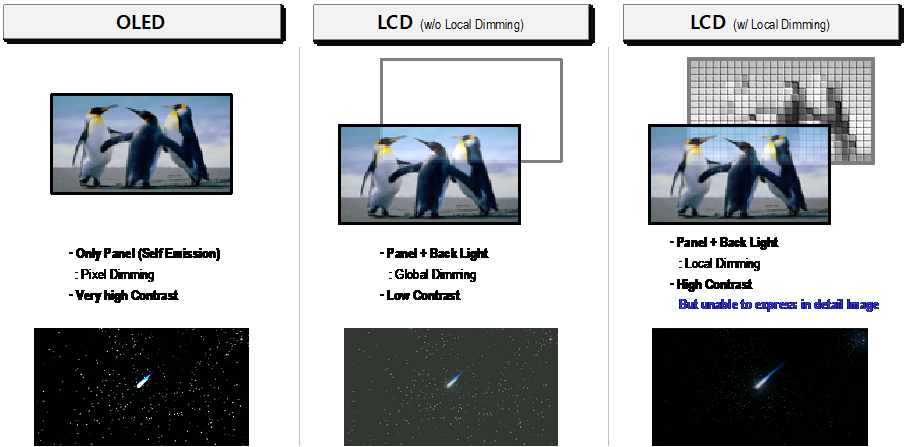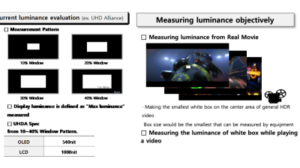In Part 2 of the article, (part 1 is here) I will discuss the differences in luminance between LCD TVs and OLED TVs and the effect of FALD on the implementation of HDR.

Part 1 investigated how QLED and OLEDs compete in front of screen performance and how QLEDs use various techniques to improve viewing angle in 4K and 8K TVs and the trade-offs selected for color rendering, resolution and contrast ratio. In 2019, Samsung and other TV brands will likely sell twice as many QLEDs TVs as all 15 brands selling OLED TVs. So why question the viability of QLEDs in the luxury TV market?
- First, Samsung downgraded the QLED label to apply to any TV of any size (greater than 43” and greater) regardless of the image processing, response time, viewing angle or contrast ratio.
- Second, LG Display sells all of the OLED TV panels it can produce at up to 2X to price of LCD panels of the same size
- Third, the average price of OLEDs TVs is around 1.5x the price of QLED TVs
- Fourth, QLEDs engineers took the easy way out, technically improving LCDs leaving product differentiation up to marketing, which targeted high share in a low margin segment, while OLEDs started the transformation to a better display
- Finally Samsung Electronics’ Display threw in the towel and announced a couple of weeks ago that it is abandoning LCD TV panels and investing $10.9b in OLED TV panel manufacturing that uses quantum dots as color converters.
The high end TV market is a mecca for technology innovation and marketing deception as the battle for supremacy of the highest profitable segment heats up. Panel sizes continue to grow, and the most popular size continues to increase reaching 65” with 75” and 88” looming in the future. Moreover, the target resolution has moved from 4K to 8K despite incomplete but growing content in 4K and virtually none in 8K. Finally, there is the application of HDR, which puts a premium on APL, contrast ratio and luminance. The pressure is on panel makers to improve the display’s viewing angle performance, increase the luminance, grow the color gamut, increase the contrast ratio and maintain or reduce the power consumption.
Part 2
Yet another factor in the assessment of TVs is the luminance and the current use of maximum luminance, which is becoming more important with the use of HDR to increase the brightness depending on the image requirements. The use of a single term works to the disadvantage of OLEDs because overall OLED luminance is constrained by a balance of lifetime and aging. In point of fact, luminance is more complicated and the average picture level (APL) is a more accurate measure of the display performance. The current measure of luminance as defined by the UHD Alliance defines max luminance for windows of 10%, 20%, 30% and 40% and then puts an OLED at 540 cd/m² with an LCD at 1,000 cd/m². A more objective measure would be to report luminance for TVs, based on how they respond to an HDR video.
 Figure 11: Alternative Approaches to Measuring Luminance – Source:LG Display – Click for higher resolution
Figure 11: Alternative Approaches to Measuring Luminance – Source:LG Display – Click for higher resolution
Comparing the luminance of a panel using a standard test pattern with a standard HDR video shows the following:
- The LCD drops from 1,257 cd/m² to 636.3 cd/m²
- The OLED drops from 692 cd/m² to 636.2 cd/m²
Clearly, the average measure does not account for the super high levels achieved by LCDs in specific HDR images like fireworks or the stars in our universe.
Figure 12: Comparison of Luminance Measurements for an LCD and OLED Panel – Source:LG Display
Local dimming was developed to improve the contrast in LCD panels. By dimming the parts of the screen that should be dark (a character in shadow, perhaps), and keeping bright the parts of the screen that should be bright (a nearby well-lit window) the apparent contrast ratio is improved. As LCD technology advanced, local dimming was adapted to work with thinner edge-lit TVs. With edge-lit LCDs, all the LEDs are along the edge of the TV, facing the center of the screen and local dimming, is a bit looser term. While, the TV can still dim areas of the screen, those areas are much larger than they are with full arrays. In the worst case, the “local dimming” could be nearly invisible, or dim huge swaths of the screen at a time, and it could result in a worse picture. In the best case, there’s a noticeable improvement in the picture quality, though not as much as there would be with full array. The pin-point highlights of HDR aren’t possible.
FALD refers to an array of individual LEDs behind the LCD panel, all pointing out through the screen toward your eyeballs. The most common method is a set number of “zones.” Depending on the TV, these could number in the dozen or more although most LCD TV makers don’t disclose the number (or even into the hundreds or thousands – Editor). Each zone is responsible for a certain area of the screen. Objects smaller than the zone (stars in the night sky, for example), don’t benefit from the local dimming, and can look muted. Also, if a zone is lit, and an adjacent zone isn’t there is a halo/bloom as that part of the screen becomes brighter than its neighboring zone.
The limit with HDR is that the pin-point sections of the image that best show HDR are essentially disabled by local dimming. For example, in a 65” TV with 1,000 dimming zones, each zone is ~1.14mm, typically much larger than the size of a star. The following example shows the effects of local dimming for an HDR image of the sky with bright stars. The OLED clearly outperforms the LCDs with and without local dimming. One additional downside of FALD is that when the stars are small and sparse in appearance, the local dimming takes over and dulls some of the images.
 Figure 12: The Effect of Local Dimming on HDR Images – Source:LG Display
Figure 12: The Effect of Local Dimming on HDR Images – Source:LG Display
Measuring the performance of displays and particularly, those for TVs is difficult and often defaults to simple and undefined terms, such as luminance, power consumption, contrast ratio. OLEDs and LCDs are in a battle for leadership in the TV market and consumers should not be taken in by the use of meaningless specifications and marketing terms. (BY)

Barry Young is the Chairman and CEO of the OLED Association

